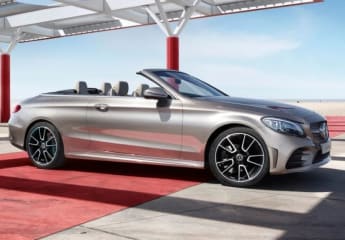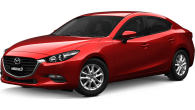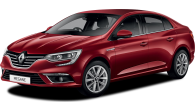As Mercedes-Benz Australia’s passenger car line-up steadily spreads across a never-ending range of market niches the evergreen C-Class remains the backbone of the brand’s local offering and sales.
It’s the template for a high-quality, well-specified and contemporary compact sedan (also available as a coupe, cabrio and wagon), comfortably outselling its German ‘big three’ competitors, the Audi A4 and BMW 3 Series.
The current fourth generation (W205) model arrived in 2014, so it’s kind of getting on. But this mild-hybrid C 200 entry version was inserted into the play as part of a comprehensive update in late 2018.
So, does it do enough to keep the three-pointed star’s most popular choice at the top of the heap? Read on to find out.
Mercedes-Benz C200 2019: EQ (hybrid)
| Engine Type | Turbo 4, 1.5L |
|---|---|
| Fuel Type | Premium Unleaded/Electric |
| Fuel Efficiency | 6.4L/100km (combined) |
| Seating | 5 |
| Price From | $37,730 - $44,330 |
| Safety Rating |
|
Is there anything interesting about its design?
8 / 10
For a brand like Mercedes-Benz the challenge of respecting the look established by cars that have gone before, gelling with other models in the current range, and moving things far enough forward to generate fresh interest is a delicate one. Focus too much on any one of those three elements and the design will be too retro, too similar, or too adventurous.
.JPG)
And notwithstanding the fact the way anything looks is a subjective call, I think the Mercedes-Benz C-Class manages that juggling act just about perfectly.
Signature elements like the sizable three-pointed star in the grille, joined to chrome louvres either side leave you in no doubt about who manufactured the car. But beyond that, the C-Class’s overall proportions make it instantly recognisable as a Benz.
A relatively long bonnet, with the cabin set well back results in a short, high rear decklid, with chrome accents around the side glass, along the rocker panels, across the boot lid and surrounding the exhaust outlets adding a hint of traditional bling.
Yet, carefully sculpted strakes on the bonnet sides, a strong character line across the top of the doors, and equally well-defined channels along the flanks’ lower third say wind tunnel as much as design inspiration (Cd figure is 0.26). The multi-row ‘LED High Performance’ headlights also add an intriguing touch of tech.
.JPG)
Inside, the look is sleek and simple. Long unbroken curves define the dash and twin-dial (12.3-inch digital) instrument binnacle, with circular ball-and-socket air vents another recognisable touch.
But the 10.25-inch multimedia screen jutting out of the dashtop gives away the current C-Class’s age, with more recent arrivals like the compact A-Class now packing the very swish twin widescreen media and instrument set-up.
That said, strategic use of high-gloss ‘piano black lacquer’ finish on the centre console, brushed metal on the door inserts, and chrome picking out key elements delivers an air of restrained quality.
Speaking of which, Merc’s ‘Artico’ faux-leather trim material deserves a special mention. Yes, it’s vinyl, but nine out of 10 people getting into your C 200 will think it’s genuine hide. And the good news is it’s as tough as old boots.
How practical is the space inside?
7 / 10
At close to 4.7m long, a fraction over our 1.8m wide, and a bit more than 1.4m tall the C-Class is dimensionally in the centre of the premium compact sedan pack. But it’s worth noting the A-Class-based CLA four-door is fractionally longer overall. Looks like those niches are starting to overlap.
.JPG)
Space in the front is generous with two big cupholders, a 12-volt outlet and coins and key storage all sitting under a folding lid.
A lidded bin between the front seats contains an SD card reader as well as two USB ports, and doubles as a padded centre armrest. The glove box is a good size and generous door pockets have a separate spot for bottles.
There’s plenty of storage in the back, including a fold-down armrest incorporating a lined storage box and twin fold-out cupholders, as well as door bins with bottle holders and map pockets on the back of each front seat, plus twin adjustable air vents.
.JPG)
Leg and toe room sitting behind my own (183cm) driving position is surprisingly good, but the headroom situation isn’t as rosy, with my noggin making firm contact with the headliner in a normal sitting posture.
And much as the C-Class sedan is able to seat five, three full-size adults across the rear seat is a short-term proposition only. Up to teenage kids will be fine.
Boot capacity is a handy 455 litres (VDA), and the C 200 swallowed our three-piece hard suitcase set (35, 68 and 105 litres) with ease, as it did the jumbo size CarsGuide pram. Drop the 40/20/40 split-folding rear seat to liberate more volume.
The load space features tie-down anchors, shopping bag hooks, and elasticised storage areas behind each wheel tub. Towing capacity is 1800kg for a braked trailer and 710kg unbraked. And don’t bother looking for a spare wheel, the tyres are run flats (a 16-inch space saver steel wheel is available as an accessory option).

Does it represent good value for the price? What features does it come with?
8 / 10
Cost of entry for the C 200, and by default the C-Class range, is $63,700 before on-road costs, which lines up with the Alfa Giulia Super ($65,900), Audi A4 40 TFSI S tronic Sport ($61,400), BMW 320i Sport Line ($63,400), Jaguar XE 2.0t Prestige ($62,770), and Lexus IS300 F Sport ($66,707).
.JPG)
A classy competitive set, and the Merc puts its best foot forward with a solid list of standard features, including 18-inch five twin-spoke alloy wheels, a nappa leather-trimmed multi-function steering wheel (with touch-sensitive controls), ambient interior lighting (with 64 colour options), electrically adjustable front seats (with electropneumatic lumbar support), dual-zone climate control, keyless start, rain-sensing wipers, auto LED headlights, the all-digital 12.3-inch instrument display (offering ‘Classic’, ‘Progressive’ and ‘Sporty’ display styles), and the 10.25-inch media display (with touchpad control) managing audio (including digital radio, Android Auto and Apple CarPlay), ‘Comand’ navigation, phone, car settings, and more.
.JPG)
Other highlights include ‘Agility Control’ adaptive suspension, ‘Dynamic Select’ with five driving modes (tweaking engine, transmission, suspension and steering tune), a reversing camera, ‘Active Parking Assist’ (with ultrasonic sensors front and rear), cruise control (with variable speed limiter), electrically folding and heated exterior mirrors, illuminated, Mercedes-Benz branded front door sill panels, and velour floor mats.
Faux leather trim will be a disappointment for some at this price point, although as mentioned earlier, it looks and feels great. Standard safety tech, of which there’s plenty, is covered in the safety section below. And overall, the C 200 is competitively priced and equipped.
What are the key stats for the engine and transmission?
8 / 10
The 1.5-litre (M264) four-cylinder engine features direct-injection, a single twin-scroll turbo, and variable valve timing (on the intake side) to produce 135kW at 5500rpm and 280Nm at 3000rpm.
.JPG)
The ‘EQ Boost’ hybrid system is built around an integrated starter generator sitting between the engine and transmission. Combining the functions of a starter motor, alternator, and electric motor it powers an electric auxiliary compressor designed to minimise turbo lag, as well as a 48-volt electrical system supplementing the standard 12-volt arrangement.
Merc says the electric compressor spools up in less than half a second, supplying boost (and an extra 10kW) before exhaust gas has had a chance to drive the turbo up to full pressure. It also harvests kinetic energy under braking to charge the battery and smooth operation of the auto engine stop/start system.
The water pump is electrically driven and governed by a specific map to adapt cooling output to the current need.
Drive goes to the rear wheels via a nine-speed ‘9G-Tronic’ automatic transmission.
How much fuel does it consume?
8 / 10
Claimed fuel economy for the combined (ADR 81/02 - urban, extra-urban) cycle is 6.4L/100 km, the C 200 emitting 145g/km of CO2 in the process.
The cars ‘EQ Boost’ system includes a gliding mode and recuperative braking with ‘intelligent engine stop’ when the vehicle is coasting, plus start/stop (operated by the belt-driven starter/alternator) is standard.
Over a week of city, suburban and freeway driving we recorded an average of 10.5L/100km at the bowser, a little higher than the on-board read-out of 10.1L/100km.
Minimum fuel requirement is 95 RON premium unleaded and you’ll need 66 litres of it to fill the tank.
What's it like to drive?
8 / 10
Mercedes-Benz claims the C 200 will accelerate from 0-100km/h in 7.7 seconds, which isn’t too shabby at all for a 1.5-litre four-cylinder engine shifting a close to 1.6-tonne sedan.
But despite the ‘EQ Boost’ system’s best efforts, we experienced some hesitation in throttle response, particularly when stepping off from standstill. That said, the start/stop works almost imperceptibly. I often have to resist a natural instinct to turn these systems off because they stop abruptly or re-start roughly, but this one is quick, quiet and smooth.
.JPG)
Once up and running throttle response is faster and more linear, and with maximum torque (280Nm) available from 3000rpm all the way to 6100 rpm mid-range acceleration is snappy. Peak power (135kW) arrives across a narrow band from 5800-6100rpm if you’re really pressing on.
The nine-speed auto enhances the car’s quietly efficient vibe, with wheel-mounted paddle shifters providing the option of more involvement with quick and positive ‘manual’ changes.
Suspension is by multi-links front and rear with the ‘Agility Control’ adaptive suspension allowing fine-tuning of the damping from comfort to sporty. And even on the standard 18s ride comfort in the softer setting is excellent without ever slipping into floaty territory. Noise levels are also impressively low.
The standard ‘Dynamic Select’ system allows adjustment of the engine, transmission, suspension and (electrically-assisted) steering tune. Rubber is top-shelf ContiSportContact run-flat (225/45f – 245/40r). Tighten things up and the C 200 is transformed into a taut and even more responsive sporty sedan.
Brakes are ventilated 305mm discs at the front and solid 300mm discs at the rear, and the pedal is agreeably progressive.
Notwithstanding the rear headroom issue mentioned earlier, the seats are comfy and supportive front and rear, all-around vision is excellent, and the ergonomics are well sorted. Although it must be said, I’m still not a fan of the gear selector wand on the right-hand side of the steering column. Uncomfortably close to an oversize indicator stalk for my liking.
Warranty & Safety Rating
What safety equipment is fitted? What safety rating?
9 / 10
If you want to talk safety Mercedes-Benz can reach into its bag of tricks and mix it with the best of them.
.JPG)
Standard active tech included on the C 200 runs to ABS, BA, EBD, stability and traction controls, a reversing camera (with dynamic guidelines), ‘Active Brake Assist’ (Merc-speak for AEB), ‘Adaptive Brake’ (with hold function, brake drying and ‘Hill Start Assist’), ‘Attention Assist’, ‘Blind Spot Assist’, and a tyre pressure warning system.
If all that doesn’t keep you out of trouble passive safety includes the ‘Pre-Safe’ accident anticipatory system, nine airbags (front, pelvis and window for driver and front passenger, side airbags for rear seat occupants and a driver’s knee bag), and the ‘Active Bonnet’ automatically tilts to minimise pedestrian injuries.
There’s even ‘crash responsive emergency lighting’, as well as a first-aid kit, warning triangle and two hi-vis safety vests in the boot.
There are three child restraint/baby capsule top tether points across the back seat, with ISOFIX anchors on the two outer positions, and the C-Class was awarded a maximum five ANCAP stars in 2014.
What does it cost to own? What warranty is offered?
7 / 10
Mercedes-Benz covers its passenger car range with a three year/unlimited km warranty, like the other two members of the German ‘Big Three’ (Audi and BMW) lagging the mainstream market where the majority of players are now at five years/unlimited km, with some at seven years.
On the upside, Mercedes-Benz Road Care assistance is included in the deal for three years.
Service is scheduled for 12 months/25,000km (whichever comes first) with pricing available on an ‘Up-front’ or ‘Pay-as-you-go’ basis.
Verdict
Five is late middle age in car years, but the Mercedes-Benz C-Class’s late 2018 refresh has kept plenty of pep in its step. The C 200 is beautifully built (in East London, South Africa), well equipped and entertaining to drive. Modest rear headroom is a miss and Merc’s warranty cover needs a boost, but factor in the standard safety, high-tech drivetrain, and ease of use and you have an impressive entry-level package.
Does the C 200 look like premium small sedan value to you? Tell us what you think in the comments below.
Pricing Guides



.JPG)

.JPG)
.JPG)
.JPG)
.JPG)
.JPG)
.JPG)





















.jpg)



.jpg)


.jpg)

.jpg)


Comments